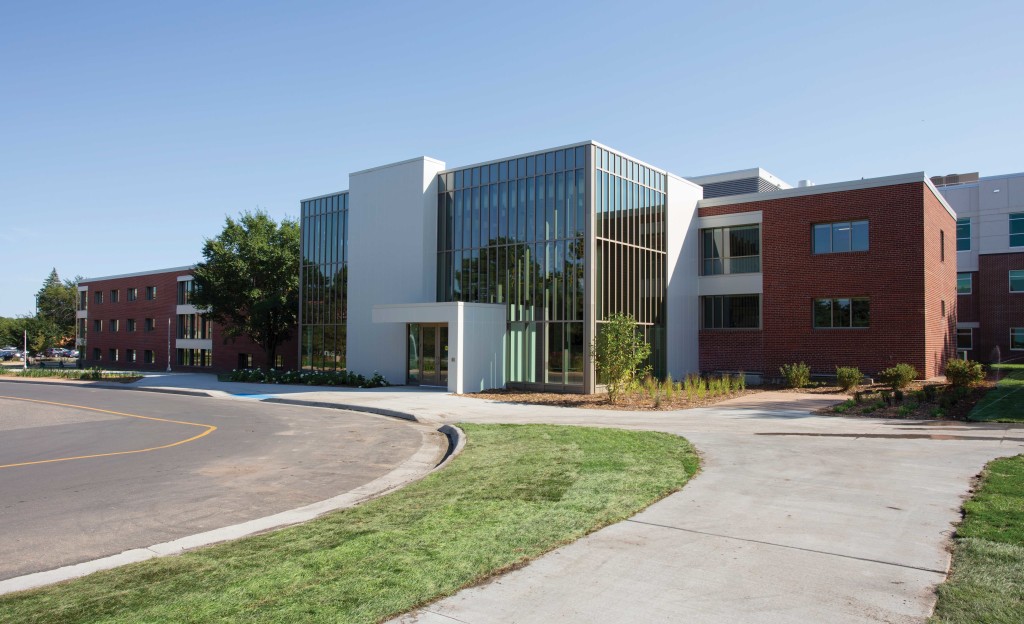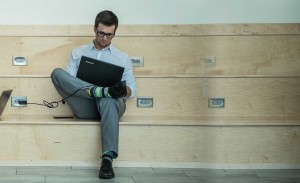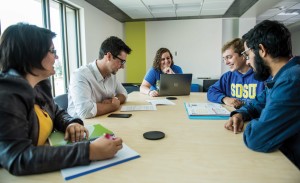From its start in 1954 as a men’s residence hall, Harding Hall has seen a few changes. None of those changes were as drastic as it becoming the new home of the Department of Economics.
The building was transformed into 40 offices and two classrooms, including the new location for the First Dakota National Bank e-Trading Education Lab.
Before moving into Harding Hall in August, Professor and Department Head Eluned Jones thought the excitement would be similar to the energy created by the First Dakota National Bank e-Trading Education Lab after it originally opened in 2015 in Berg Agricultural Hall. That facility is now in Harding Hall’s lower level.
“We immediately noticed there’s a change in energy from both students and faculty. It’s fun to watch, it’s fun to feel, it’s palpable at times,†Jones said.
The department has five majors—agricultural business, agricultural and resource economics, business economics, economics and entrepreneurial studies—and minors in accounting, agricultural business, agricultural marketing, banking and financial services, economics, entrepreneurial studies, human resource management, management and marketing, and a master’s degree in economics.
“I read that a person made a comment that I think is very apropos for our situation, and that was business is the new or modern mission of a land-grant university,†she said. “The original intent was to train people in the mechanical and agricultural arts, which evolved into engineering and the agricultural sciences.
“Now, where’s the access points for students from rural areas? There are fewer and fewer people needed at the farm level and more who are needed downstream and the further you get downstream in the food system, the more you need the business skills,†Jones continued. “When you talk about accessibility for the rural population to enter the workforce and have the appropriate skills, you’re now talking about business skills. It’s an evolutionary step … you could say it’s a disruptive one but it’s definitely part of the new mission of a land-grant university.â€
It’s one area South Dakota State is ready to address. It started by changing the business economics specialization to a major.
“We were already teaching business classes, but it wasn’t very apparent to students on campus and employers,†Jones said, noting the move was in line with the Higher Learning Commission standards and to meet Association to Advance Collegiate Schools of Business International accreditation.
“With a 60 percent turnover of faculty in the last five years due to retirements, we had the opportunity to re-align the faculty with respect to disciplinary knowledge in the five majors and to meet student demand for business-oriented majors,†she said. “What’s exciting to me is that it’s unique in this country to have all of this disciplinary range in one department without silos. They’re all in one physical place and there are no barriers to them working together. There are huge opportunities for synergies.â€
And plenty of spaces for students to not only study and work on projects, but to also meet with faculty. Jones saw firsthand the students working together at unexpected hours when walking around with Duane Sander, one of Daktronics’ founders and a former engineering professor.
“We see more students coming in to use the room outside of classroom hours,†Jones said. “A few weeks ago, I ran into Duane in the corridor, and he asked if I would help him find his old office. While we were walking around, there were two or three graduate students working in the analyst lab, a few students in the training lab and others using the active-learning classroom. And that’s after 6 p.m. on a Friday—that’s the sort of environment that’s growing now.
“This is a place where they can study, a place that has facilities for them to study and has access to guidance from faculty,†she continued. “Obviously, we can’t tell yet how much they can accomplish and achieve, but without a doubt, any time there’s more time for interaction between students and faculty and students with each other, there’s more learning potential. You feel that; you see that, and you can pick up on the excitement from the students. They’re taking possession of it, and it’s fun to watch them have pride in that.â€
One of those students is Nik Medvedev, who is pursuing degrees in economics and data science while serving as president of the Investment Club and as a senior analyst with the Student-Managed Investment Fund.
“I think there is more of a business-school feel instead of a traditional classroom or department look,†he said. “The cool approach about this building is that there are no traditional classrooms; instead, we have collaborative spaces.
“And the trading lab closely resembles what you would see on Wall Street,†Medvedev continued, noting it was one of the features that drew him to attend State. “We now have trading desks for each senior analyst, who gets to cover their sector at their own desk, and we can also share our research for groups at other tables; it’s a more cohesive experience. I think the reason we have way more students interested this year is because we have this new building.â€
The department held an open house in late October to showcase the facility and the commissioned artwork, “connect. interweave, evolve.†by School of Design faculty member Molly Wicks. The artwork was influenced by the South Dakota economic flow. Geographic information system mapping of paths of movement provided an organic grid for this multidimensional piece.
Jones invites others to see the changes.
“To our alumni, come back and see what we are now and see how things are changing; don’t assume things have stayed the same because they really haven’t,†she said. “We try to make sure our graduates have a competitive advantage, which is what the e-trading lab does, but also are at least at par with other graduates. The e-trading lab showed what we can do by winning the 2017 student-managed portfolio competition. We’re just getting started to give them opportunities to prove their worth.â€
– Matt Schmidt









